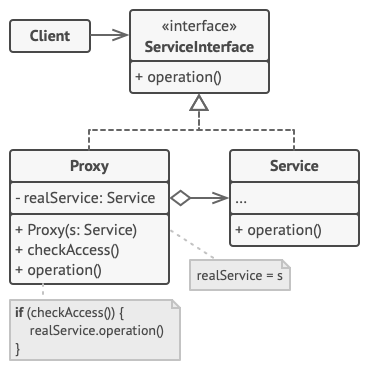代理模式(Proxy)
意图
代理模式是一种结构型模式,让你能够提供对象的替代品或其占位符。代理控制着对于原对象的访问,并允许在将请求提交给对象前后进行一些处理。
问题
为什么要控制对于某个对象的访问呢?举个例子:有这样一个消耗大量系统资源的巨型对象,你只是偶尔需要使用它,并非总是需要。

你可以实现延迟初始化:在实际有需要时再创建该对象。对象的所有客户端都要执行延迟初始代码。不幸的是,这很可能会带来很多重复代码。
在理想情况下,我们希望将代码直接放入对象的类中,但这并非总是能实现:比如类可能是第三方封闭库的一部分。
解决方案
代理模式建议新建一个与原服务对象接口相同的代理类,然后更新应用以将代理对象传递给所有原始对象客户端。代理类接收到客户端请求后会创建实际的服务对象,并将所有工作委派给它。

这有什么好处呢?如果需要在类的主要业务逻辑前后执行一些工作,你无需修改类就能完成这项工作。由于代理实现的接口与原类相同,因此你可将其传递给任何一个使用实际服务对象的客户端。
结构

- 服务接口(Service Interface)声明了服务接口。代理必须遵循该接口才能伪装成服务对象。
- 服务(Service)类提供了一些实用的业务逻辑。
- 代理(Proxy)类包含一个指向服务对象的引用成员变量。代理完成其任务(例如延迟初始化、记录日志、访问控制和缓存等)后会将请求传递给服务对象。通常情况下,代理会对其服务对象的整个生命周期进行管理。
- 客户端(Client)能通过同一接口与服务或代理进行交互,所以你可在一切需要服务对象的代码中使用代理。
实现方式
- 如果没有现成的服务接口,你就需要创建一个接口来实现代理和服务对象的可交换性。从服务类中抽取接口并非总是可行的,因为你需要对服务的所有客户端进行修改,让它们使用接口。备选计划是将代理作为服务类的子类,这样代理就能继承服务的所有接口了。
- 创建代理类,其中必须包含一个存储指向服务的引用的成员变量。通常情况下,代理负责创建服务并对其整个生命周期进行管理。在一些特殊情况下,客户端会通过构造函数将服务传递给代理。
- 根据需求实现代理方法。在大部分情况下,代理在完成一些任务后应将工作委派给服务对象。
- 可以考虑新建一个构建方法来判断客户端可获取的是代理还是实际服务。你可以在代理类中创建一个简单的静态方法,也可以创建一个完整的工厂方法。
- 可以考虑为服务对象实现延迟初始化。
代码演示
12345678910111213141516171819202122232425262728293031323334353637383940414243444546474849505152535455565758596061626364656667686970717273747576777879808182838485868788899091929394959697 | using System;namespace RefactoringGuru.DesignPatterns.Proxy.Conceptual{ // The Subject interface declares common operations for both RealSubject and // the Proxy. As long as the client works with RealSubject using this // interface, you'll be able to pass it a proxy instead of a real subject. public interface ISubject { void Request(); } // The RealSubject contains some core business logic. Usually, RealSubjects // are capable of doing some useful work which may also be very slow or // sensitive - e.g. correcting input data. A Proxy can solve these issues // without any changes to the RealSubject's code. class RealSubject : ISubject { public void Request() { Console.WriteLine("RealSubject: Handling Request."); } } // The Proxy has an interface identical to the RealSubject. class Proxy : ISubject { private RealSubject _realSubject; public Proxy(RealSubject realSubject) { this._realSubject = realSubject; } // The most common applications of the Proxy pattern are lazy loading, // caching, controlling the access, logging, etc. A Proxy can perform // one of these things and then, depending on the result, pass the // execution to the same method in a linked RealSubject object. public void Request() { if (this.CheckAccess()) { this._realSubject.Request(); this.LogAccess(); } } public bool CheckAccess() { // Some real checks should go here. Console.WriteLine("Proxy: Checking access prior to firing a real request."); return true; } public void LogAccess() { Console.WriteLine("Proxy: Logging the time of request."); } } public class Client { // The client code is supposed to work with all objects (both subjects // and proxies) via the Subject interface in order to support both real // subjects and proxies. In real life, however, clients mostly work with // their real subjects directly. In this case, to implement the pattern // more easily, you can extend your proxy from the real subject's class. public void ClientCode(ISubject subject) { // ... subject.Request(); // ... } } class Program { static void Main(string[] args) { Client client = new Client(); Console.WriteLine("Client: Executing the client code with a real subject:"); RealSubject realSubject = new RealSubject(); client.ClientCode(realSubject); Console.WriteLine(); Console.WriteLine("Client: Executing the same client code with a proxy:"); Proxy proxy = new Proxy(realSubject); client.ClientCode(proxy); } }} |
|---|
执行结果:
1234567 | Client: Executing the client code with a real subject:RealSubject: Handling Request.Client: Executing the same client code with a proxy:Proxy: Checking access prior to firing a real request.RealSubject: Handling Request.Proxy: Logging the time of request. |
|---|
参考原文:代理设计模式

